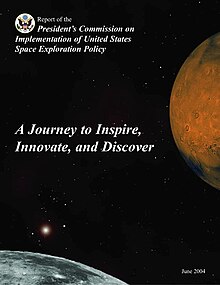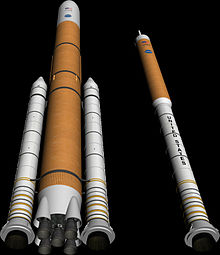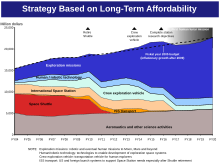Vision for Space Exploration: Difference between revisions
Kelvin Case (talk | contribs) |
Kelvin Case (talk | contribs) |
||
| Line 39: | Line 39: | ||
In February 2009, the Aerospace Technology Working Group released an in-depth report asserting that the Vision had several fundamental problems with regard to politics, financing, and general space policy issues and that the initiative should be rectified or replaced.<ref>{{Cite web|last=Hsu|first=Feng|coauthors=Cox, Ken|title=Sustainable Space Exploration and Space Development - A Unified Strategic Vision|publisher=[http://www.atwg.org/ Aerospace Technology Working Group]|date=February 20, 2009|url=http://www.spaceref.com/news/viewsr.html?pid=30702|accessdate=October 9, 2009}}</ref> |
In February 2009, the Aerospace Technology Working Group released an in-depth report asserting that the Vision had several fundamental problems with regard to politics, financing, and general space policy issues and that the initiative should be rectified or replaced.<ref>{{Cite web|last=Hsu|first=Feng|coauthors=Cox, Ken|title=Sustainable Space Exploration and Space Development - A Unified Strategic Vision|publisher=[http://www.atwg.org/ Aerospace Technology Working Group]|date=February 20, 2009|url=http://www.spaceref.com/news/viewsr.html?pid=30702|accessdate=October 9, 2009}}</ref> |
||
Another |
Another perspective is that the VSE provides no practical benefits to the taxpayers that justify its extraordinary cost, that the primary mission of NASA, from its beginnings as NACA in 1917 until the launch of Sputnik, was to provide science and technology of practical value to America.<ref name="Engineer in Charge">{{Cite web|last=Hansen|first=James R.|title=Engineer in Charge|publisher=[[NASA]]|date=1987|url=http://history.nasa.gov/SP-4305/contents.htm|accessdate=November 28, 2009}}</ref> Apollo signaled a shift to geopolitical symbolism, the Shuttle and Station were a return to more pragmatic goals. Human spaceflight could be made sustainable by reducing its cost sufficiently to make flight to low earth orbit practical for customers to actually go there for research, business, and tourism.<ref name="Practical Benefits for America">{{Cite web|last=Woodard|first=Daniel|title=Practical Benefits for America|date=2009|url=http://www.nasa.gov/pdf/383313main_25%20-%2020090808.3.practical-benefits.pdf|accessdate=November 28, 2009}}</ref> |
||
But "a large portion of the scientific community" concurs that [[NASA]] is not "expanding our scientific understanding of the universe" in either "the most effective or cost efficient way."<ref name="Tumlinson">Tumlinson, Rick. Testimony to United States Senate, originally dated October 29, 2003. Senate re-dated February 2010. [http://commerce.senate.gov/pdf/tumlinson102903.doc]. See p. 8.</ref> Proponents argue that a permanent settlement on the moon would drastically reduce costs for further space exploration missions. [[President George W. Bush]] voiced this sentiment when the vision was first announced (see quote above), and the [[United States Senate]] has re-entered testimony<ref name="Tumlinson" /> by [[Space Frontier Foundation]] founder [[Rick Tumlinson]] offered previously to the [[United States Senate Committee on Commerce, Science and Transportation]] advocating this particular perspective.<ref name="Tumlinson" /> The reason that the [[National Space Society]] regards a return to the Moon as a high [[space program]] priority is to begin development of the knowledge and identification of the industries unique to the Moon, because "such industries can provide economic leverage and support for [[NASA]] activities, saving the government millions."<ref>Tumlinson, Rick. Testimony to United States Senate. [http://commerce.senate.gov/pdf/tumlinson102903.doc], p. 13.</ref> |
But "a large portion of the scientific community" concurs that [[NASA]] is not "expanding our scientific understanding of the universe" in either "the most effective or cost efficient way."<ref name="Tumlinson">Tumlinson, Rick. Testimony to United States Senate, originally dated October 29, 2003. Senate re-dated February 2010. [http://commerce.senate.gov/pdf/tumlinson102903.doc]. See p. 8.</ref> Proponents argue that a permanent settlement on the moon would drastically reduce costs for further space exploration missions. [[President George W. Bush]] voiced this sentiment when the vision was first announced (see quote above), and the [[United States Senate]] has re-entered testimony<ref name="Tumlinson" /> by [[Space Frontier Foundation]] founder [[Rick Tumlinson]] offered previously to the [[United States Senate Committee on Commerce, Science and Transportation]] advocating this particular perspective.<ref name="Tumlinson" /> The reason that the [[National Space Society]] regards a return to the Moon as a high [[space program]] priority is to begin development of the knowledge and identification of the industries unique to the Moon, because "such industries can provide economic leverage and support for [[NASA]] activities, saving the government millions."<ref>Tumlinson, Rick. Testimony to United States Senate. [http://commerce.senate.gov/pdf/tumlinson102903.doc], p. 13.</ref> |
||
As Tumlinson's additionally notes, the goal is to "open space ... to human settlement ... to create ways to harvest the resources ... not only saving this precious planet, but also ... assuring our survival."<ref>Ibidem, Tumlinson, pp. 6-7.</ref> Regarding "the Moon, NASA should support early exploration now...."<ref>Ibid, p. 14.</ref> |
As Tumlinson's additionally notes, the goal is to "open space ... to human settlement ... to create ways to harvest the resources ... not only saving this precious planet, but also ... assuring our survival."<ref>Ibidem, Tumlinson, pp. 6-7.</ref> Regarding "the Moon, NASA should support early exploration now...."<ref>Ibid, p. 14.</ref> As well, the total energy needed for transit between the Moon and Mars is actually much less than between the Moon and Earth, so lunar base activity could make a large impact on building a Mars base.<ref>Please refer to [[Lunar space elevator#Possible uses]].</ref> |
||
Another concern noted is that on Earth, the unique resources of NASA could instead be harnessed to make America more competitive in aeronautics, commercial spacecraft and launch vehicle technology, environmental monitoring, and biomedical sciences.<ref name="Practical Benefits for America" /> |
Another concern noted is that on Earth, the unique resources of NASA could instead be harnessed to make America more competitive in aeronautics, commercial spacecraft and launch vehicle technology, environmental monitoring, and biomedical sciences.<ref name="Practical Benefits for America" /> |
||
Revision as of 01:15, 15 February 2010

The Vision for Space Exploration is the United States space policy announced on January 14, 2004 by President George W. Bush. It is seen as a response to the Space Shuttle Columbia disaster, the state of human spaceflight at NASA, and a way to regain public enthusiasm for space exploration.
Outline
The Vision calls for the space program to:[1] [2]
- Complete the International Space Station by 2010
- Retire the Space Shuttle by 2010
- Develop the Orion spacecraft (formerly known as the Crew Exploration Vehicle) by 2008, and conduct its first human spaceflight mission by 2014
- Develop Shuttle-Derived Launch Vehicles
- Explore the Moon with robotic spacecraft missions by 2008 and crewed missions by 2020
- Explore Mars and other destinations with robotic and crewed missions
Outlining some of the advantages, U.S. President George W. Bush addressed the following:[2]
Establishing an extended human presence on the moon could vastly reduce the costs of further space exploration, making possible ever more ambitious missions. Lifting heavy spacecraft and fuel out of the Earth's gravity is expensive. Spacecraft assembled and provisioned on the moon could escape its far lower gravity using far less energy, and thus, far less cost. Also, the moon is home to abundant resources. Its soil contains raw materials that might be harvested and processed into rocket fuel or breathable air. We can use our time on the moon to develop and test new approaches and technologies and systems that will allow us to function in other, more challenging environments.
One of the stated goals for the Constellation program is to gain significant experience in operating away from Earth's environment,[3] as the White House contended, to embody a "sustainable course of long-term exploration."[4] The Ares boosters are a cost-effective approach[5] — entailing the Ares V's enormous, unprecedented cargo-carrying capacity[6] — transporting future space exploration resources to the Moon's[5] weaker gravity field.[7] While simultaneously serving as a proving ground for a wide range of space operations and processes, the Moon may serve as a cost-effective construction, launching and fueling site for future space exploration missions.[8] For example, future Ares V missions could cost-effectively[5] deliver raw materials for future spacecraft and missions to a Moon-based[5] space dock positioned as a counterweight to a Moon-based space elevator.[9]

NASA has also outlined plans for manned missions to the far side of the Moon.[10] All of the Apollo missions have landed on the near side. Unique products may be producible in the nearly limitless extreme vacuum of the lunar surface, and the Moon's remoteness is the ultimate isolation for biologically hazardous experiments. The Moon would become a proving ground also toward the development of In-Situ Resource Utilization, or "living off the land" (i.e., self-sufficiency) for permanent human outposts.
In a position paper issued by the National Space Society (NSS), a return to the Moon should be considered a high space program priority, to begin development of the knowledge and identification of the industries unique to the Moon. The NSS believes that the Moon may be a repository of the history and possible future of our planet, and that the six Apollo landings only scratched the surface of that 'treasure'. According to NSS, the Moon's far side, permanently shielded from the noisy Earth, is an ideal site for future radio astronomy (for example, signals in the 1-10 MHz range cannot be detected on Earth because of ionosphere interference.[11])
When the Vision was announced in January 2004, the U.S. Congress and the scientific community gave it a mix of positive and negative reviews. For example, Rep. Dave Weldon (R-Fla.) said, "I think this is the best thing that has happened to the space program in decades." Though physicist and outspoken manned spaceflight opponent Robert L. Park stated that robotic spacecraft "are doing so well it's going to be hard to justify sending a human,"[4] the vision announced by the President states that "robotic missions will serve as trailblazers — the advanced guard to the unknown."[2] Others, such as the Mars Society, have argued that it makes more sense to avoid going back to the Moon and instead focus on going to Mars first.[12]
Initial return missions as proposed by President Bush and NASA, can be done through space operations using the existing launch infrastructure and assets developed by the shuttle and International Space Station programs, plus existing expendable launch vehicles, with a minimum of new research and development programs.[citation needed] The lessons learned from international cooperation during ISS construction and operations, can be improved upon and extended to human missions to the Moon, Mars and elsewhere. Initial missions could place scientific equipment on the Moon and return samples from areas never explored, such as the polar regions. Extent of water and other volatiles important to lunar industrialization could be determined. As future reusable launch systems begin operations, reducing cost and enabling higher flight rates, Earth-Moon traffic can become routine.[citation needed]
Throughout much of 2004, it was unclear whether the U.S. Congress would be willing to approve and fund the Vision for Space Exploration. However, in November 2004, Congress passed a spending bill which gave NASA the $16.2 billion that President Bush had sought to kick-start the Vision. According to then-NASA chief Sean O'Keefe, that spending bill “was as strong an endorsement of the space exploration vision, as any of us could have imagined.”[13] In 2005, Congress passed S.1281, the NASA Authorization Act of 2005, which explicitly endorses the Vision.[14]
Former NASA Administrator Michael Griffin is a big supporter of the Vision, but modified it somewhat, saying that he wants to reduce the four year gap between the retirement of the Space Shuttle and the first manned mission of the Crew Exploration Vehicle.[15]
Lunar Architecture
NASA's Lunar Architecture forms a key part of its Global Exploration Strategy, also known as the Vision for Space Exploration. The First part of the Lunar Architecture is the Lunar Reconnaissance Orbiter, which launched in June 2009 on board an Atlas V. The preliminary design review was completed in February 2006 and the critical design review was completed in November 2006. An important function of the orbiter will be to look for further evidence that the increased concentrations of hydrogen discovered at the moons poles is in the form of lunar ice. After this the lunar flights will make use of the new Ares I and Ares V rockets.[16]
Critical perspectives

In December 2003, Buzz Aldrin voiced criticism for NASA's vision and objectives, stating that the goal of sending astronauts back to the moon was "more like reaching for past glory than striving for new triumphs".[17]
In February 2009, the Aerospace Technology Working Group released an in-depth report asserting that the Vision had several fundamental problems with regard to politics, financing, and general space policy issues and that the initiative should be rectified or replaced.[18]
Another perspective is that the VSE provides no practical benefits to the taxpayers that justify its extraordinary cost, that the primary mission of NASA, from its beginnings as NACA in 1917 until the launch of Sputnik, was to provide science and technology of practical value to America.[19] Apollo signaled a shift to geopolitical symbolism, the Shuttle and Station were a return to more pragmatic goals. Human spaceflight could be made sustainable by reducing its cost sufficiently to make flight to low earth orbit practical for customers to actually go there for research, business, and tourism.[20]
But "a large portion of the scientific community" concurs that NASA is not "expanding our scientific understanding of the universe" in either "the most effective or cost efficient way."[21] Proponents argue that a permanent settlement on the moon would drastically reduce costs for further space exploration missions. President George W. Bush voiced this sentiment when the vision was first announced (see quote above), and the United States Senate has re-entered testimony[21] by Space Frontier Foundation founder Rick Tumlinson offered previously to the United States Senate Committee on Commerce, Science and Transportation advocating this particular perspective.[21] The reason that the National Space Society regards a return to the Moon as a high space program priority is to begin development of the knowledge and identification of the industries unique to the Moon, because "such industries can provide economic leverage and support for NASA activities, saving the government millions."[22]
As Tumlinson's additionally notes, the goal is to "open space ... to human settlement ... to create ways to harvest the resources ... not only saving this precious planet, but also ... assuring our survival."[23] Regarding "the Moon, NASA should support early exploration now...."[24] As well, the total energy needed for transit between the Moon and Mars is actually much less than between the Moon and Earth, so lunar base activity could make a large impact on building a Mars base.[25]
Another concern noted is that on Earth, the unique resources of NASA could instead be harnessed to make America more competitive in aeronautics, commercial spacecraft and launch vehicle technology, environmental monitoring, and biomedical sciences.[20]
See also
- Aurora programme
- Colonization of the Moon
- Crew Exploration Vehicle
- Crew Space Transportation System
- Decadal Planning Team
| class="col-break " |
- DIRECT
- Exploration Systems Architecture Study
- Google Lunar X Prize
- Human Lunar Return study
- Human spaceflight
- Lunar Reconnaissance Orbiter
| class="col-break " |
References
- ^ "The Vision for Space Exploration" (PDF). NASA. February2004. Retrieved December 5, 2009.
{{cite web}}: Check date values in:|date=(help) - ^ a b c "President Bush Announces New Vision for Space Exploration Program". NASA. January 14, 2004. Retrieved June 17, 2009.
- ^ Please refer to Constellation program.
- ^ a b "FAQ: Bush's New Space Vision". space.com. Retrieved February 7, 2008.
- ^ a b c d "NASA - Ares I Crew Launch Vehicle". NASA. April 29, 2009. Retrieved May 13, 2009.
- ^ Creech, Steve and Phil Sumrall. "Ares V: Refining a New Heavy Lift Capability". NASA.
- ^ Williams, Dr. David R. (February 2, 2006). "Moon Fact Sheet". NASA (National Space Science Data Center). Retrieved 2008-12-31.
- ^ Highlights on Lunar Base Designs
- ^ Pearson, Jerome (2005). "Lunar Space Elevators for Cislunar Space Development Phase I Final Technical Report" (PDF).
{{cite web}}: Unknown parameter|coauthors=ignored (|author=suggested) (help) - ^ http://www.timesonline.co.uk/tol/news/world/article742757.ece
- ^ LIFE on Moon
- ^ "The Mars Society Frequently Asked Questions". marssociety.org. Retrieved February 7, 2008.
- ^ "Congress Grants $16.2 Billion Budget for NASA". space.com. Retrieved February 7, 2008.
- ^ "NASA Authorization Act" (PDF). gpo.gov. Retrieved February 7, 2008.
- ^ "A Message From Administrator Michael Griffin". nasa.gov. Retrieved February 7, 2008.
- ^ "NASA Unveils Global Exploration Strategy and Lunar Architecture". NASA. 2006.
- ^ Aldrin, Buzz (December 5, 2003). "Fly Me To L1" (PDF). The New York Times. Retrieved November 14, 2009.
- ^ Hsu, Feng (February 20, 2009). "Sustainable Space Exploration and Space Development - A Unified Strategic Vision". Aerospace Technology Working Group. Retrieved October 9, 2009.
{{cite web}}: External link in|publisher=|coauthors=ignored (|author=suggested) (help) - ^ Hansen, James R. (1987). "Engineer in Charge". NASA. Retrieved November 28, 2009.
- ^ a b Woodard, Daniel (2009). "Practical Benefits for America" (PDF). Retrieved November 28, 2009.
- ^ a b c Tumlinson, Rick. Testimony to United States Senate, originally dated October 29, 2003. Senate re-dated February 2010. [1]. See p. 8.
- ^ Tumlinson, Rick. Testimony to United States Senate. [2], p. 13.
- ^ Ibidem, Tumlinson, pp. 6-7.
- ^ Ibid, p. 14.
- ^ Please refer to Lunar space elevator#Possible uses.
